Attention! There is extremely high voltage in the ignition system, so all precautions must be observed when working on parts related to the ignition system. This applies not only to the ignition distributor, control unit and high-voltage wires, but also to adjacent parts associated with this system, such as contacts on spark plugs, a tachometer and any diagnostic equipment.
General checks
1. After setting the ignition key to position "ON" ("ON") and supply voltage from the battery to the ECM/PCM electronic control unit, the need for service is indicated by a warning lamp "SERVICE ENGINE SOON" ("Have engine serviced immediately").
2. Check all high voltage wires for tightness, cuts, corrosion, and other signs of poor contact. Incorrect connection or poor wire contact may cause the ignition to fail. Also check for carbon deposits inside the spark plug tips.
3. Using a spark plug tester, check that the secondary voltage is correct (25.000 V) spark plug voltage (see illustration).
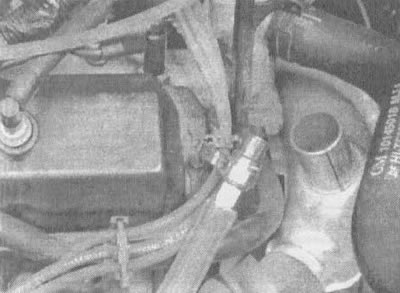
6.3. When using a calibrated ignition tester, disconnect the high voltage wire from the spark plug, connect the tester to the nearest point "masses" (e.g. to the valve cover bolt) and turn on the starter. If the high voltage value is sufficient, a spark will jump between the end of the electrode and the body of the tester
4. Using an ohmmeter, measure the resistance of the wires. The resistance of each wire must be no more than 30,000 ohms.
High Power Ignition System (HEI)
5. On the attached diagnostic card (see illustration 6.5) shows sequence diagrams for checking the HEI ignition system. Also shown are the pin assignments in the connector used to test the ignition unit.

{{Открыть большую картинку в новом окне}} »
6.5. Sequence diagram for checking the ignition system on vehicles equipped with the HEI system
6. Check N1. Two high-voltage wires are checked to establish that there are no breaks in these wires.
N1A check. If a spark occurs after disconnecting the four-pin connector of the ignition distributor, this means that the output voltage level from the inductive sensor is too low for normal operation of the HEI system.
7. Check N2. The presence of a spark means that the distributor cap or its rotor is faulty.
Note. The jumping of several sparks in a row, followed by their complete absence, must be regarded in the same way as the absence of sparks.
8. Check N3 (see illustration 6.5). Usually on terminals "WITH" And "+" voltage should be equal to the battery voltage. The voltage below the battery indicates that the circuit from the distributor to the coil or to the ignition switch has a very high resistance or there is an open in it. If the voltage at the terminal "WITH" low, and on the terminal "+" is 10 volts or higher, which means that the circuit section from the terminal is broken "WITH" to the ignition coil or to the primary winding of the ignition coil.
9. Test N4 is used to detect a short circuit in the block or circuit short circuit on "mass" in the area from the ignition coil to the block. The ignition distributor block must be switched off; in this case, the voltage in the circuit, provided that it is in good condition, should be about 12 V. If the unit is turned on, the voltage will drop, but will be higher than 1 V. This can lead to damage to the ignition coil due to overheating. With the primary winding of the ignition coil open, through the block from the terminal "BAT" only a small part of the voltage will fall on the tachometer terminal.
10. When applying a voltage of 1.5-8 V to the terminal "R" block, the latter should turn on, and the voltage at the tachometer terminal should drop to about 7-9 V.
11. Checking N5 allows you to determine the presence of malfunctions in the block and the ignition coil, and also to find out whether the measuring sensor generates an appropriate signal to turn on the block. This test can be performed using a 1.5-8 V battery. Using a test lamp makes it possible to check the terminal "R" by simpler means. You can also use some types of digital multimeters to run the block by setting them to the low resistance measurement mode (diode test position). In this case, the terminals of the multimeter will have a voltage sufficient to start the unit. The voltage value at the terminals when the multimeter is set to the resistance measurement position can be determined using a second measuring device or can be found from its technical characteristics indicated by the manufacturer in the instructions for the multimeter.
12. Performing test N6 with the unit off, checks for a spark. If no spark occurs, then most likely one of the ignition coils is faulty, because by this phase of the test, most unit faults should already be detected. GM HEI block tester (Kent Moore J-24642-F or equivalent) allows you to determine which coil is faulty. If you don't have one, contact your General Motors dealer for assistance.
Direct ignition system (DIS)
13. If misfiring occurs when the engine is idling, perform the first check indicated in the diagnostic card (see illustration 6.13). If the misfiring occurs while the engine is running under load, refer to the test shown in Illustration 6.18.
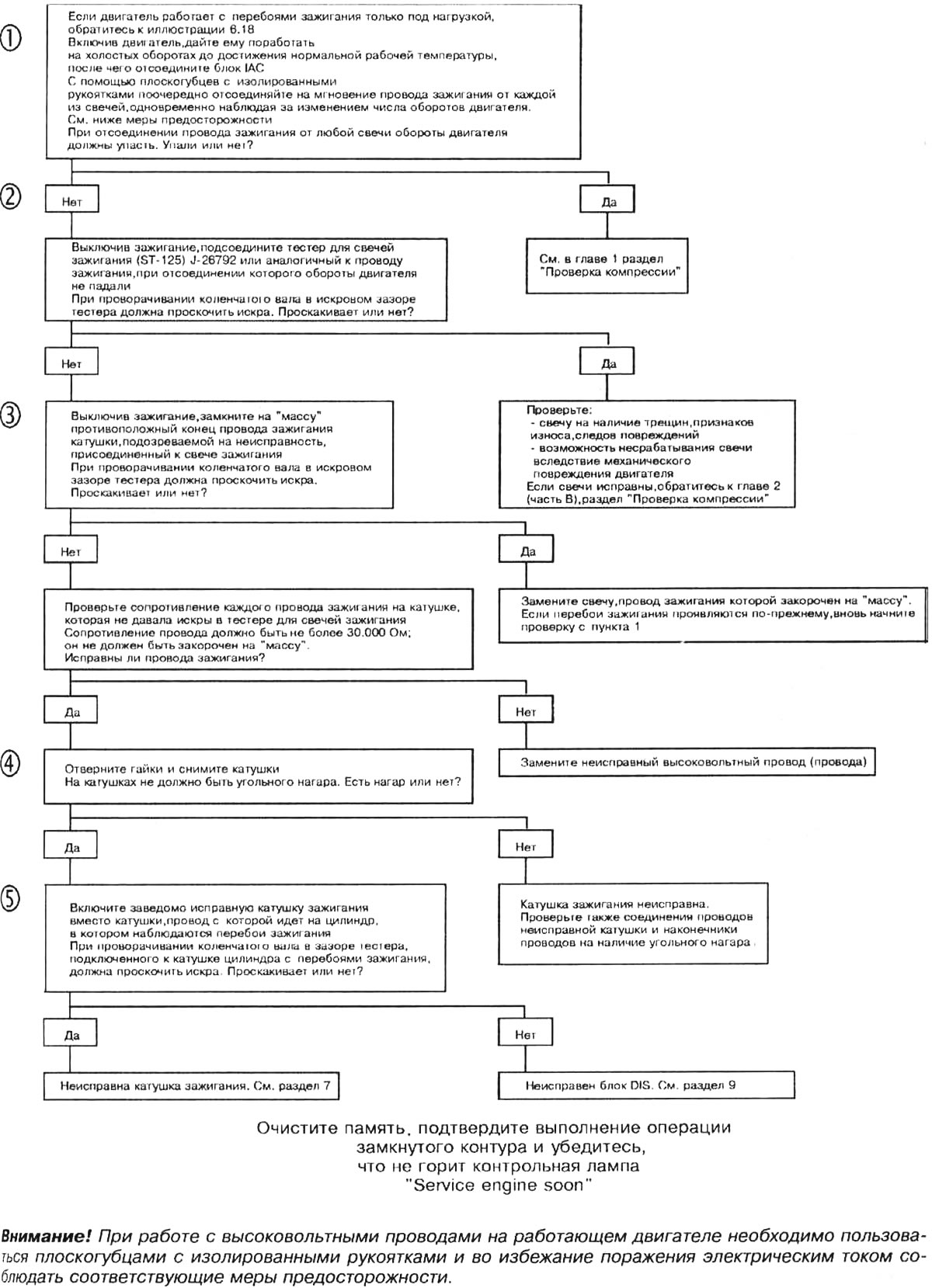
{{Открыть большую картинку в новом окне}} »
6.13. Sequence diagram for checking the direct ignition system when the engine is idling (checks 1-5)
14. Check N2. Using a spark plug tester, check that the voltage at the spark plug matches the voltage generated by the secondary winding of the coil (25.000 V).
15. Check N3. If, after shorting the opposite ignition wire to "mass" a spark jumps in the spark gap of the tester, this means that the resistance of the spark plug in which misfires occur is too high. In addition, poor contact between the ignition wire and the spark plug may be the cause of the misfires. Also check for any soot deposits inside the spark plug tip.
16. Check N4. If there is soot deposits, replace the ignition coil and make sure that the ignition wire terminals of this coil are clean and tight. Excessively high wire resistance or loose contacts can damage the ignition coil.
17. Check N5. If the misfiring disappears when the coils are swapped, then the first coil is bad. If they still occur, then the ignition unit is faulty. This test can also be performed by replacing a non-sparking coil with one known to be good.
18. If the engine is running under load with intermittent ignition, perform test N6, which is described in the appropriate diagram. Use a spark plug tester to check the voltage at the spark plug (should be 25.000 V). A spark should jump in the spark gap of the device when it is connected to all four wires. This simulates the condition of the engine under load.

{{Открыть большую картинку в новом окне}} »
6.18. Sequence diagram for checking the DIS system when the engine is running under load (checks NN 6-9)
19. Check N7. If, after shorting the opposite high voltage wire to "mass" a spark jumps in the spark gap of the tester, which means that the resistance of the spark plug is too high. In addition, a faulty or loose contact of the ignition wire with the spark plug can be the cause of misfiring. Also check if there is any soot deposits inside the protective cover of the spark plug.
20. Check N8. If there is soot deposits, replace the ignition coil and make sure that the ignition wire terminals of this coil are clean and tight. Excessively high wire resistance or loose contacts can damage the ignition coil.
21. Check N9. If, when replacing the suspicious coil of one of the other ignition coils, a spark appears regularly, this means that this coil is faulty. If interruptions in the ignition remain, the cause of this is a malfunction in the unit. This test can also be performed by replacing a non-sparking coil with one known to be good.
Control unit with ignition coils
22. Test N1 makes it possible to check the ability of the system to deliver a voltage of at least 25.000 V.
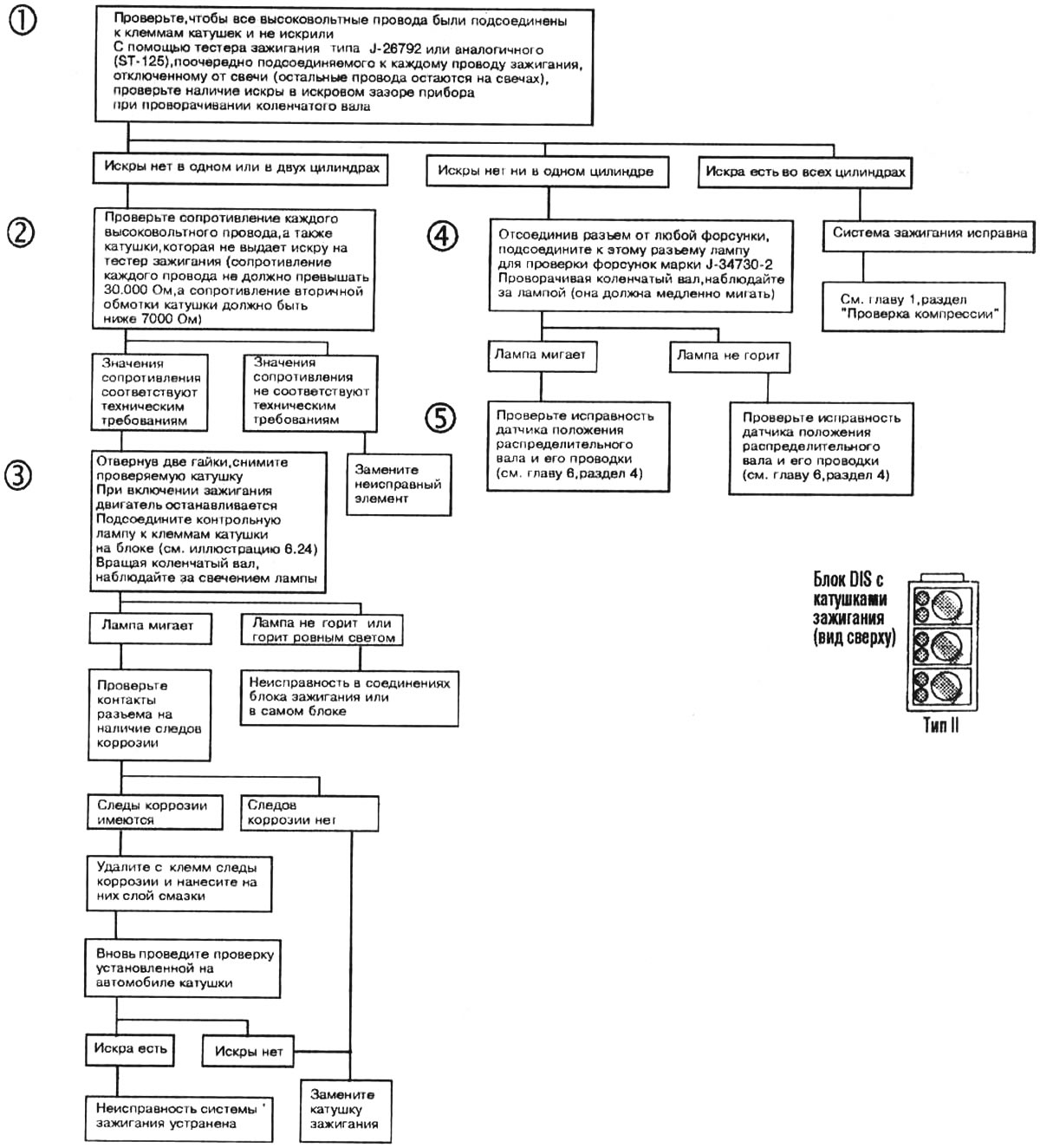
{{Открыть большую картинку в новом окне}} »
6.22. Diagram of the test sequence of the DIS unit and the ignition coil (checks NN 1-5)
23. Check N2. With an open high-voltage wire or the secondary winding of the coil, sparks in the cylinder will not jump. Therefore, you should check both ignition wires of the coil and measure the resistance of its secondary winding. If the measured resistance is higher than the upper limit specified in the specifications, but less than "infinity", then such a coil will most likely make it possible to start the engine, however, under certain circumstances, it can cause its malfunction.
24. Check N3. Serves to check the operation of the starting circuit in the ignition unit (see illustration). Here, the flashing lamp indicates that the unit is operating normally.
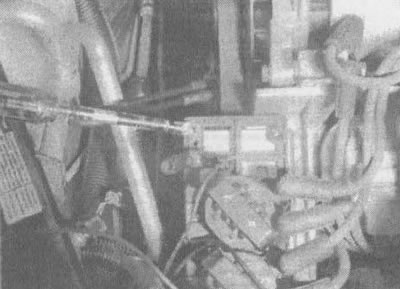
6.24. By connecting a test lamp to the coil terminals on the ignition unit, check if it flashes when cranking the crankshaft
25. Check N4. Here, a slow flashing of the lamp means that the signal from the crankshaft position sensor does not reach the PCM (see illustration).
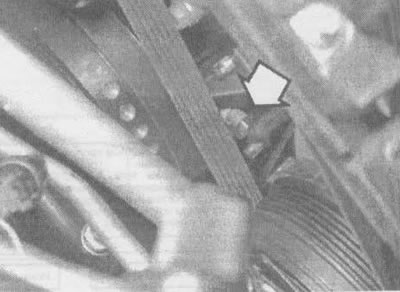
6.25. The crankshaft position sensor on the 3.8L engine is located in the timing cover next to the crankshaft pulley
26. Check N5. In this case, the flashing of the lamp means that the camshaft position sensor and its control circuits are working. The fault may be in the position sensor, in the electrical circuits of the sensor, or in the ignition unit.
27. Check N6. After turning on the ignition, listen to the operation of the fuel pump for the first two seconds. If it works, that means the fuse is good.
28. Check N7. Allows you to determine if the cause of the malfunction is a short to "mass" signal from the crankshaft position sensor or a malfunction in the signal circuit of the camshaft position sensor (see chapter 6, section 4).
29. The ignition unit supplies power to the sensor. Checking N8 (see section 9) allows you to establish the presence of a malfunction in the unit or in its electrical circuits.
30. Test N6 can be used to determine if the fuse is good. Checking N9 allows you to determine exactly where the fault is - in the section of the circuit between the fuse and the ignition unit, or in the unit itself.
The crankshaft turns, but the engine does not start
31. If, with the ignition on and open on "mass" test output connector ALDL control lamp "SERVICE ENGINE SOON" flashes, check the ignition and PCM.
32. Installing a lamp to check the injectors (You can find it at almost every auto parts store), check if the control signals from the PCM are going to the fuel injectors. Here, a blinking lamp will indicate that the PCM is controlling the injectors and that the PCM's ignition tell-tale signal to the PCM is correct.
33. Using a spark plug tester, check if the problem is with the ignition system or with the fuel supply system (see illustration 6.3).
34. Check the correct operation of the fuel pump and the low fuel signal relay (see chapter 4, section 3). After the ignition is switched on, the fuel pump should only run for two seconds.
35. Check if the PCM receives a control signal from the ignition system (see section 9).
